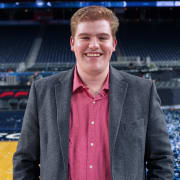Ten Critical NBA Draft Stay-or-Go Decisions

We’re just a week away from the NCAA’s draft decision deadline, the last day players can withdraw from the 2024 NBA draft while still retaining college eligibility. The NIL landscape has leveled the playing field in a major way for college programs hoping to retain top talent, and in some cases, players would actually be taking a pay cut from what they could have earned in college if they can’t secure a guaranteed contract at the next level. That makes for some interesting looming stay-or-go decisions for the sport’s biggest stars. Here’s a preview of 10 of the most impactful decisions to come.
Caleb Love, Arizona Wildcats
Once on a one-and-done trajectory, Love is now pondering a fifth year of college basketball. Going back to Arizona, where he had a career year in 2023–24 and would likely be a preseason All-American, makes a lot of sense for Love, who’d more likely than not go undrafted. That said, Love has little left to accomplish at the college level, and it’d be hard to blame him for wanting to start his pro journey. He told Sports Illustrated during the G League Elite Camp that nothing is “set in stone” yet about his decision, and it wouldn’t be a surprise if this one came down to the wire.
Mark Sears, Alabama Crimson Tide
Sears’s decision is huge for college basketball. If the Alabama native is back with the Tide for another season, there will be a legitimate case for Nate Oats’s squad to be the preseason No. 1 team in the polls thanks to a loaded portal class. Sears missed one NBA combine scrimmage with a minor injury and wasn’t spectacular in the one game he did play, but his ability to make tough shots, generate paint touches and create for others makes him an appealing pro. Sears said in Chicago he’s “all in” on the draft process, but since he did retain his eligibility, nothing is final until that decision deadline hits.
Alex Karaban, UConn Huskies
Karaban has played two seasons of college basketball and won two national championships. Is it time to go out on a high? The Massachusetts native’s shooting ability and cerebral floor game make him a decent bet to be at least a second-round draft choice, but it would likely take a very good NBA situation to coax him out of the college ranks. If someone promises a guaranteed contract, it’d be very hard for Karaban to say no, but if not, it feels like we’ll get one more season of Karaban in a Huskies uniform. He told reporters in Chicago he expects his decision will come down “to the last minute.”
Hunter Sallis, Wake Forest Demon Deacons
An explosive junior season at Wake Forest after two quiet seasons with the Gonzaga Bulldogs has Sallis squarely on the draft radar. He averaged 18 points, 4.1 rebounds and 2.5 assists per game while shooting 49% from the field and 41% from three, finally showcasing the talent that made him a blue-chip recruit in high school. A return would give Wake Forest its best chance yet under Steve Forbes at making the men’s NCAA tournament. Sallis indicated he was open to a return to school while in Chicago, and this decision feels as 50-50 as any on the board.
Johnny Furphy, Kansas Jayhawks
Furphy’s rise from low- to mid-major recruit to potential one-and-done in a year’s time has been meteoric. His draft range feels like somewhere between picks Nos. 20 and 40, and it’s hard to turn down the guaranteed money that comes with a selection in that range. Kansas has left a scholarship open for Furphy, but Bill Self has recruited the wing position hard this spring. It’d be a surprise, though perhaps not a shock, if Furphy runs it back for a second season in Lawrence, Kan.
Walter Clayton Jr., Florida Gators
Clayton’s game translated incredibly well from the mid-major level up to Florida, where he averaged over 17 points per game and dropped 33 in the NCAA tournament against the Colorado Buffaloes. He should be one of the best guards in the country assuming a return to school, which would make sense given Clayton seems unlikely to hear his name called on draft night. Another big season at Florida playing more as a traditional point guard could boost his stock in the 2025 draft.
Matthew Murrell, Ole Miss Rebels
Ole Miss has reeled in a monster transfer portal class. The one missing piece: a dynamic shooting wing with defensive chops. Murrell likely wouldn’t be asked to be Ole Miss’s leading scorer like he was each of the past two seasons, but his pro stock could benefit while playing in a more traditional three-and-D role. It’s believed Murrell is leaning toward staying in the draft at this point, but we’ll see if that changes before the deadline.
Payton Sandfort, Iowa Hawkeyes
Sandfort had a rough combine showing in the scrimmages, but that small sample size shouldn’t overshadow a season of elite shooting at Iowa. A popular NBA comparison will be Boston Celtics sharpshooter Sam Hauser, though the two possess different body types. If the poor performance in Chicago leads to a return to school, it’d be a huge boost to Iowa’s hopes of getting back to the NCAA tournament after missing the dance in 2024.
Eric Dixon, Villanova Wildcats
This is a critical year ahead for Kyle Neptune’s future at Villanova, and with several other key departures already set in stone, the Wildcats really need Dixon to return to school. While Dixon has improved his perimeter game throughout his college career, he still wasn’t invited to either event in Chicago last week, a good indicator of where his stock stands. If he does come back to school, he’ll likely be suspended three games for participating in the Portsmouth Invitational in April.
David Jones, Memphis Tigers
Jones struggled in scrimmage action in Chicago, which might help clarify his stay-or-go decision. Jones is undersized for a wing after measuring under 6’4” without shoes and was a bit wild in the scrimmages, forcing shots after a cold shooting start. He indicated he’s still 50-50 on whether to go back to school or turn pro, but he’d likely be better served at this point going back and looking to build off a breakout junior season with the Tigers.
